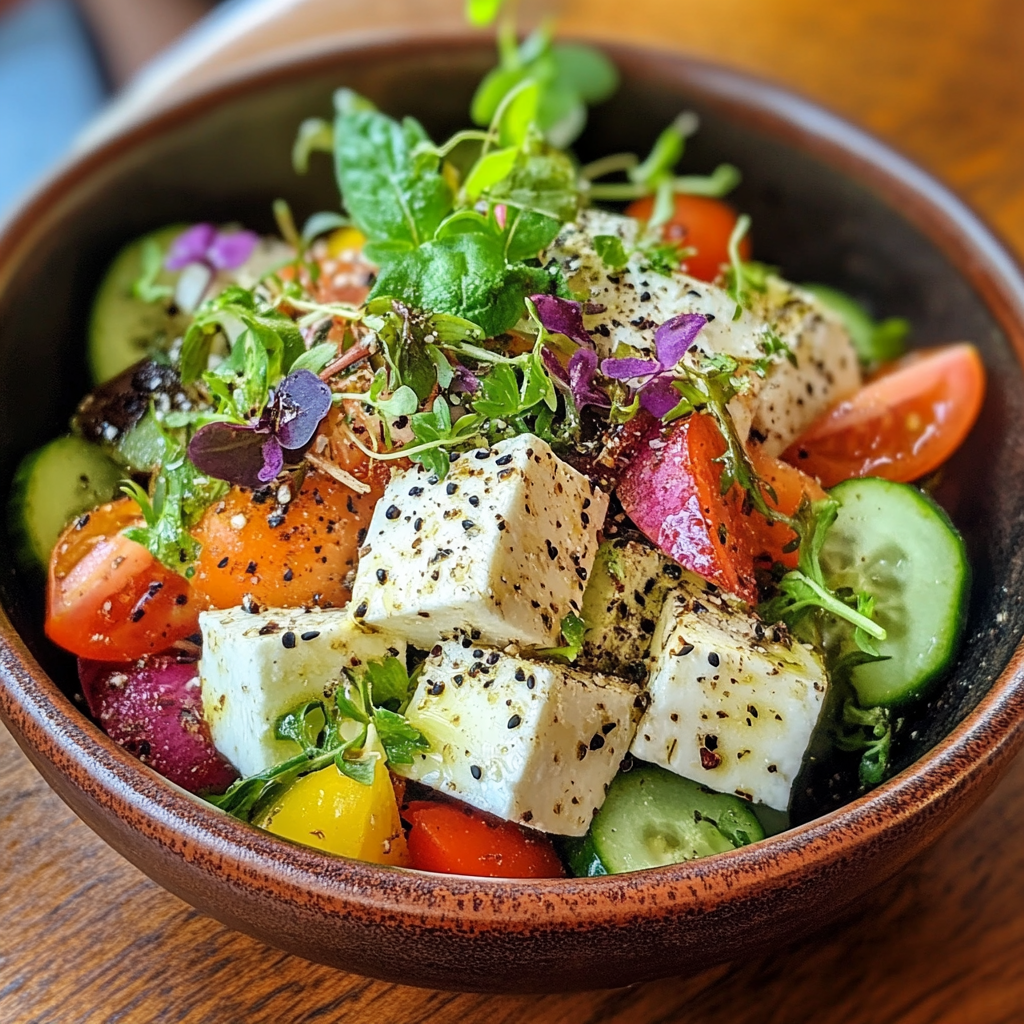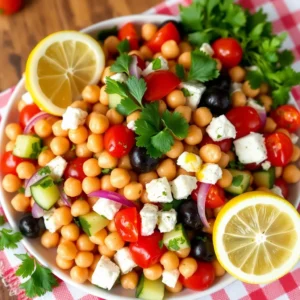Have you ever found yourself staring into the fridge at 6 PM, desperately needing something fresh and vibrant that won’t keep you chained to the kitchen? I’ve been there too many times to count, friends. That’s why this Fresh Greek Salad has become my weeknight superhero – swooping in to save dinner with minimal effort and maximum flavor.
Picture this: crisp cucumbers, juicy tomatoes, tangy olives, and creamy cheese all coming together in a dance of Mediterranean flavors that’ll transport you straight to a seaside taverna (no passport required). The best part? It takes just 15 minutes from cutting board to table, making it perfect for those nights when cooking feels like climbing Mount Olympus.
Why You’ll Love This Fresh Greek Salad
There’s something magical about a dish that can be both incredibly simple and utterly magnificent at the same time. This Fresh Greek Salad embodies that beautiful contradiction. Every time I serve it, I’m reminded of why this humble Mediterranean staple has stood the test of time.
First, it’s ridiculously quick to make. On those evenings when the kids have soccer practice, work emails are still pinging, and the dog needs walking, a 15-minute meal feels like a gift from the gods. Second, it’s incredibly versatile – perfect as a light lunch, a refreshing side dish, or even as a complete meal when you add some protein.
But what really makes this salad special is how it celebrates the beauty of simple, quality ingredients. There’s nowhere to hide in a dish this straightforward, which means every component gets to shine. The cucumber brings refreshing crunch, the tomatoes add juicy sweetness, the olives contribute that distinctive Mediterranean tang, and the cheese offers creamy richness that ties everything together.
The Heart and Soul of a Greek Salad
Did you know that in Greece, this salad is called “Horiatiki,” which translates to “village salad”? It originated as a farmer’s meal – a simple combination of whatever was fresh from the garden, dressed with olive oil and sprinkled with local cheese. There’s something incredibly comforting about serving your family a dish with such humble, hardworking roots.
What I love most about making this traditional Greek salad is that it connects us to generations of people who understood that good food doesn’t need to be complicated. It just needs to be fresh, thoughtfully prepared, and shared with people you care about. When I place this colorful bowl at the center of my table, I feel like I’m participating in a beautiful culinary tradition that spans centuries.
Ingredients You’ll Need
Let’s gather what we need for this Mediterranean masterpiece. The beauty of a Fresh Greek Salad is that it requires minimal ingredients, but each one plays an important role:
For the salad base:
- 1 large cucumber, sliced into half-moons (look for firm, dark green ones)
- 1 cup cherry tomatoes, halved (the sweeter, the better!)
- ½ red onion, thinly sliced
- ½ bell pepper, thinly sliced (red, yellow, or orange for beautiful color)
- ¼ cup Kalamata olives, pitted
- ½ cup feta cheese, crumbled or cubed (or your favorite plant-based alternative)
For the dressing:
- 2 tablespoons extra-virgin olive oil (this is where quality really matters)
- 1 tablespoon freshly squeezed lemon juice
- 1 teaspoon dried oregano
- Salt and freshly ground black pepper to taste
Optional add-ins to make it your own:
- A handful of fresh greens like romaine, arugula, or spinach
- 1 tablespoon capers for extra tanginess
- Grilled chicken or chickpeas for a protein boost
- Fresh herbs such as mint or parsley for brightness
A quick note about ingredients: don’t skimp on quality here. Since we’re working with so few components, each one needs to pull its weight. Seek out the juiciest tomatoes and the creamiest cheese you can find. Trust me, your taste buds will thank you!
How to Make the Perfect Fresh Greek Salad
The simplicity of this salad belies how impressive it can be when properly prepared. Follow these steps for a Greek salad that would make any yiayia (Greek grandmother) proud:
Step 1: Prep Your Veggies Like a Pro
First things first – let’s get our vegetables ready. I like to think of this as therapeutic rather than a chore. There’s something deeply satisfying about transforming whole vegetables into a beautiful array of shapes and colors.
Slice your cucumber into half-moons about ¼-inch thick. If your cucumber has particularly thick or bitter skin, you might want to peel it partially, creating striped patterns that will look gorgeous in your finished salad.
Halve your cherry tomatoes. If you can find a mix of colors, go for it – red, yellow, and orange tomatoes create a stunning visual effect.
Now for the red onion – the flavor powerhouse that can sometimes be a little too powerful. Slice it thinly, then place the slices in a bowl of cold water for about 10 minutes. This little trick mellows out the sharpness while keeping all that wonderful flavor. After soaking, drain and pat dry.
Finally, slice your bell pepper into thin strips or bite-sized pieces. I prefer to use colorful varieties like red, yellow, or orange rather than green, as they’re sweeter and add beautiful pops of color.
Step 2: Assemble Your Mediterranean Canvas
Grab a large mixing bowl – bigger than you think you’ll need. Having extra space makes tossing much easier and prevents ingredients from escaping over the sides (we’ve all been there, chasing tomatoes across the kitchen floor!).
Add your cucumber, cherry tomatoes, soaked red onion, bell pepper, and Kalamata olives to the bowl. Gently toss these ingredients together, distributing them evenly throughout the salad. The key word here is “gently” – we want to preserve the integrity of each vegetable.
Step 3: Whisk Up a Simple but Perfect Dressing
In a small bowl, combine your olive oil, freshly squeezed lemon juice, dried oregano, salt, and pepper. Whisk until well combined.
This is another moment where quality makes a difference. A good extra-virgin olive oil brings fruitiness and depth to your dressing that you just can’t get from lower-quality alternatives. And please, squeeze a real lemon – the bottled stuff just isn’t the same for this particular recipe.
I like to taste my dressing at this point and adjust as needed. Sometimes I add a bit more lemon for extra brightness, or a pinch more oregano if I’m craving that distinctive herbal note. Make it your own!
Step 4: Bring It All Together
Now for the big moment – dressing your salad. Pour your olive oil mixture over the vegetables, then toss gently to coat everything evenly. Again, a light touch is important here; we want to preserve the beautiful shapes and textures of our vegetables.
Finally, add your feta cheese. Whether you prefer it crumbled or cubed is entirely up to you. I sometimes like to reserve a little extra to sprinkle on top just before serving for a picture-perfect presentation.
If you’re adding any optional ingredients, now’s the time. Fresh herbs can be gently torn and scattered throughout, while protein additions like grilled chicken or chickpeas can be folded in or arranged on top.
Tips for Greek Salad Success
Even though this Fresh Greek Salad is wonderfully simple, there are a few insider tips I’ve gathered over years of making it that can take your creation from good to “can-I-please-have-the-recipe” amazing.
The Cucumber Conundrum
Ever sliced into a cucumber only to find it’s filled with large, watery seeds that dilute your salad’s flavor? Here’s my fix: opt for English cucumbers (sometimes called hothouse cucumbers) whenever possible. They have fewer seeds and a thinner skin, meaning less prep and better texture.
If you’re stuck with regular cucumbers, don’t worry! Just slice them lengthwise and use a spoon to scrape out the seedy center before cutting. Yes, it’s an extra step, but it takes seconds and makes a world of difference. Your salad won’t end up swimming in cucumber water by the time you’re ready for seconds!
The Tomato Timing
Tomatoes are the heart and soul of this salad, but they can also be its downfall if not handled properly. Store-bought tomatoes often lack flavor because they’re refrigerated – a tomato crime if you ask me! For the juiciest, most flavorful experience, keep your tomatoes at room temperature until you’re ready to use them.
And if you’re making this salad ahead of time, consider adding the tomatoes last minute. Nothing ruins a Greek salad faster than sad, mushy tomatoes that have released all their juices and diluted that gorgeous dressing. If your tomatoes aren’t quite as flavorful as you’d like (hello, winter months!), a tiny pinch of sugar can wake them up. It sounds strange, but it really works!
The Cheese Choice
While traditional Greek salad calls for feta, I’ve found that not all feta is created equal. The pre-crumbled stuff in plastic containers? It’ll do in a pinch, but it often contains anti-caking agents that affect both flavor and texture.
If possible, seek out feta sold in blocks and packed in brine. This style has a creamier texture and more complex flavor that elevates your salad instantly. I like to cube it rather than crumble it – those little cheese pockets distribute better throughout the salad and provide lovely bursts of salty creaminess.
My Greek Salad Story
The first time I served this Fresh Greek Salad to my family, my kids looked at it with the suspicion only children can muster when confronted with something colorful and vegetable-based. “What’s THAT?” my son asked, poking at an olive with his fork like it might spring to life.
Fast forward to today, and this salad has become such a staple in our house that my daughter actually requested it for her birthday dinner last year. Yes, a SALAD! For a BIRTHDAY! Parents of picky eaters, there is hope!
What changed? I think it was the interactive element. One night, tired of the dinner table negotiations, I set up a “build your own Greek salad” bar with all the components in separate bowls. Suddenly, vegetables became fun. My kids loaded up on their favorites (heavy on the cheese, light on the onions), and a family tradition was born.
Now, our Greek salad nights are some of my favorite memories – everyone gathered around the table, passing bowls, debating the perfect olive-to-tomato ratio, and connecting over simple, delicious food. It’s a powerful reminder that sometimes the simplest recipes create the richest experiences.
Fresh Greek Salad FAQs
Can I make this Fresh Greek Salad ahead of time?
Absolutely! This Mediterranean beauty can be prepped up to 24 hours in advance, with one important caveat: keep the dressing separate until just before serving. I like to prep all the vegetables, store them in an airtight container in the refrigerator, and mix up the dressing in a small jar. When you’re ready to eat, just pour, toss, add the cheese, and voilà – fresh flavors without the last-minute rush. If you do dress it ahead of time, the vegetables will release more juices and soften a bit, creating more of a marinated salad effect – still delicious, just different!
How can I turn this Greek salad into a complete meal?
One of the reasons I love this Fresh Greek Salad so much is its versatility. To transform it from side dish to main event, just add a protein! Grilled chicken is a classic choice that pairs beautifully with these Mediterranean flavors. For a vegetarian option, chickpeas add hearty texture and protein while maintaining the salad’s authentic Greek vibe. Want something a little special? Try adding grilled shrimp or even slices of lamb. And don’t forget about serving options – this salad is absolutely divine stuffed into a warm pita pocket for a Greek-inspired sandwich that makes lunch feel like a Mediterranean getaway.
What can I substitute if I don’t like olives?
I get it – olives can be polarizing! While they do provide that distinctive Mediterranean flavor, this Fresh Greek Salad can still shine without them. For a similar briny, tangy note, try capers instead. They bring that same salty punch in a smaller package. Another option is to add extra feta cheese for saltiness and some diced avocado for richness. And if you’re looking for something completely different but still flavorful, try tossing in some toasted pine nuts or walnuts for crunch and depth. Remember, cooking is all about making recipes work for YOUR taste buds!
A Mediterranean Conclusion to Brighten Your Table
As we wrap up our Fresh Greek Salad journey, I hope I’ve convinced you to give this vibrant Mediterranean classic a spot in your regular meal rotation. What I love most about this dish is how it embodies the essence of good cooking – taking simple, quality ingredients and letting them shine with minimal interference.
In our busy lives, it’s easy to overcomplicate food, to think that something delicious must be difficult or time-consuming. This Fresh Greek Salad reminds us that some of the most satisfying dishes are also the simplest. It’s a colorful invitation to slow down, appreciate fresh flavors, and connect with a culinary tradition that values quality over complexity.
Whether you’re serving it at a backyard barbecue, packing it for lunch, or placing it at the center of your family dinner table, this salad brings a little Mediterranean sunshine to any occasion. The bright colors, crisp textures, and bold flavors are guaranteed to lift spirits and satisfy appetites.
So the next time you find yourself in a dinner rut or lacking inspiration, remember this Fresh Greek Salad – your 15-minute ticket to Mediterranean bliss. Your taste buds (and your schedule) will thank you!
More Delicious Recipes to Explore
If you enjoyed this Fresh Greek Salad, you might also love these other tasty creations:
- Mediterranean Stuffed Bell Peppers – Another Mediterranean-inspired dish that pairs perfectly with this salad
- Easy Homemade Tzatziki Sauce – A creamy Greek cucumber yogurt dip that makes an excellent accompaniment
- Quick Lemon Garlic Shrimp Pasta – Another weeknight wonder with Mediterranean flavors
For more information about the health benefits of Mediterranean cuisine, check out Harvard Health’s article on the Mediterranean Diet, which explains why dishes like this Fresh Greek Salad are not just delicious but nutritious too.
You might also enjoy learning about the history of Greek cuisine from Greece Travel to understand the cultural significance behind this beloved salad.



